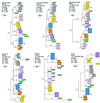Gene genealogies reveal global phylogeographic structure and reproductive isolation among lineages of Fusarium graminearum, the fungus causing wheat scab
- PMID: 10869425
- PMCID: PMC16643
- DOI: 10.1073/pnas.130193297
Gene genealogies reveal global phylogeographic structure and reproductive isolation among lineages of Fusarium graminearum, the fungus causing wheat scab
Abstract
During the past decade, the plant disease called scab or Fusarium head blight of wheat and barley has reached epidemic proportions in North America and elsewhere in the world. Scab is an economically devastating plant disease, not only because it causes significant reduction in seed yields and quality, but also because infested seeds are often contaminated with trichothecene and estrogenic mycotoxins that pose a serious threat to animal health and food safety. To test whether the primary etiological agent of scab, the fungus Fusarium graminearum, is panmictic throughout its range, allelic genealogies were constructed from six single-copy nuclear genes from strains selected to represent the global genetic diversity of this pathogen. Excluding one hybrid strain, all six genealogies recovered the same seven biogeographically structured lineages, suggesting that they represent phylogenetically distinct species among which gene flow has been very limited during their evolutionary history. Parsimony analysis of the combined data set comprising 7,120 aligned nucleotide characters resolved most relationships among the seven lineages of the F. graminearum clade and related fusaria included in the study. Phylogenetic evidence is also presented for introgressive hybridization and intragenic recombination among lineages of the F. graminearum clade in nature.
Figures



References
-
- McMullen M, Jones R, Gallenberg D. Plant Dis. 1997;81:1340–1348. - PubMed
-
- Dubin H J, Gilchrist L, Reeves L, McNab A, editors. Fusarium Head Scab: Global Status and Prospects. Mexico City: Centro Internacional de Mejoramíento de Maíz y Trigo; 1997.
-
- Cook R J. In: Fusarium: Diseases, Biology, and Taxonomy. Nelson P E, Toussoun T A, Cook R J, editors. University Park, PA: Pennsylvania State Univ. Press; 1981. pp. 39–52.
-
- Salas B, Steffenson B J, Casper H H, Prom L K. Cereal Res Commun. 1997;25:483–487.
-
- Proctor R H, Hohn T M, McCormick S P. Mol Plant Microbe Interact. 1995;8:593–601. - PubMed
Publication types
MeSH terms
Substances
Associated data
- Actions
- Actions
- Actions
- Actions
- Actions
- Actions
- Actions
- Actions
- Actions
- Actions
- Actions
- Actions
- Actions
- Actions
- Actions
- Actions
- Actions
- Actions
- Actions
- Actions
- Actions
- Actions
- Actions
- Actions
- Actions
- Actions
- Actions
- Actions
- Actions
- Actions
LinkOut - more resources
Full Text Sources
Other Literature Sources
Miscellaneous

